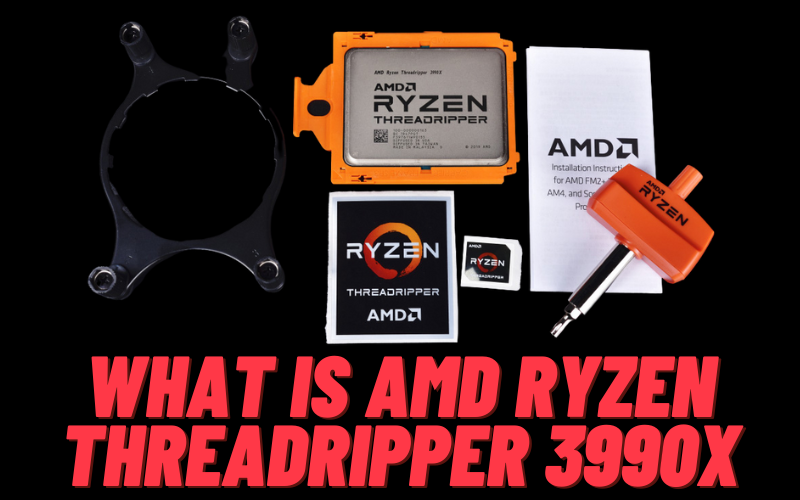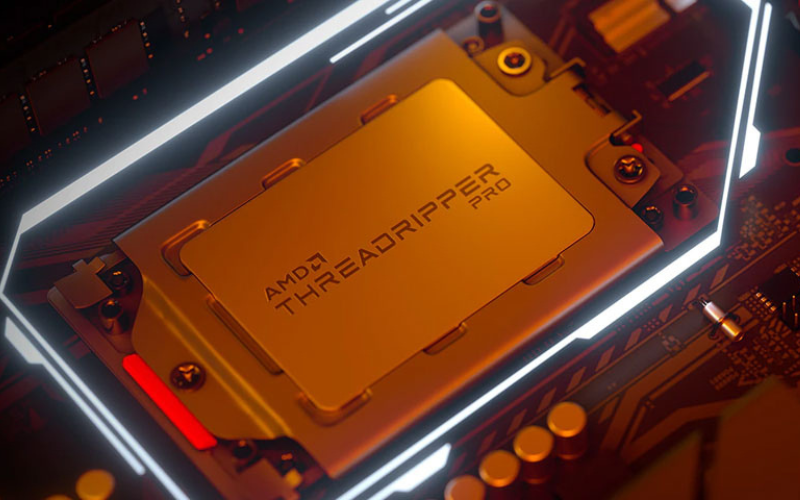When AMD launched the Ryzen Threadripper 3990X in early 2020, it fundamentally altered the landscape of high-end desktop (HEDT) computing. As the world’s first 64-core processor for the consumer market, it brought a level of parallel processing power previously reserved for expensive enterprise-grade servers. It was a groundbreaking achievement built on the 7nm Zen 2 architecture, designed for professionals in 3D rendering, visual effects, and data science.
However, the technology sector moves at a relentless pace. Several generations of CPUs have been released, bringing new architectures, platform technologies like DDR5 and PCIe 5.0, and significant improvements in efficiency and single-core performance. This review provides a retrospective analysis of the Threadripper 3990X, examining its specifications and performance in the context of today’s market to offer a clear perspective on its current relevance.
The 3990X in 2025: A Generational Leap in Performance
While the 3990X remains a capable processor for specific highly-threaded tasks, it has been definitively surpassed by its successors. The introduction of the Zen 4-based Threadripper 7000 series marked a significant technological leap. To understand this evolution, it’s helpful to see a direct comparison.
Comparison Table: AMD Ryzen Threadripper 3990X vs. Modern Successors
This table contrasts the original 3990X with a comparable successor from the Threadripper 7000 series, the 7970X, and the flagship workstation-class 7995WX, illustrating the advancements in core technology and platform capabilities.
| Feature | AMD Ryzen Threadripper 3990X (2020) | AMD Ryzen Threadripper 7970X (2023) | AMD Ryzen Threadripper PRO 7995WX (2023) |
| CPU Cores / Threads | 64 / 128 | 32 / 64 | 96 / 192 |
| Architecture | Zen 2 | Zen 4 | Zen 4 |
| Max. Boost Clock | 4.3 GHz | 5.3 GHz | 5.1 GHz |
| Base Clock | 2.9 GHz | 4.0 GHz | 2.5 GHz |
| Total L3 Cache | 256 MB | 128 MB | 384 MB |
| Platform Socket | sTRX4 | sTR5 | sWRX9 |
| PCIe Support | 64 Lanes @ PCIe 4.0 | 48 Lanes @ PCIe 5.0 | 128 Lanes @ PCIe 5.0 |
| Memory Support | Quad-Channel DDR4-3200 | Quad-Channel DDR5-5200 (RDIMM) | 8-Channel DDR5-5200 (RDIMM) |
| Default TDP | 280W | 350W | 350W |
Key Takeaway: Newer Threadripper CPUs, even those with fewer cores like the 7970X, offer significantly higher clock speeds, the superior efficiency of the Zen 4 architecture, and support for faster DDR5 memory and next-generation PCIe 5.0 devices. This results in stronger performance in both single-threaded and many multi-threaded workloads.

An In-Depth Look at the Threadripper 3990X’s Core Specifications
The 3990X was an engineering marvel of its time. Understanding its foundational specs is key to appreciating both its strengths and its current limitations.
- Cores and Threads: 64 cores and 128 threads provide massive parallel processing capability.
- Clock Speeds: A base clock of 2.9 GHz and a maximum boost clock of up to 4.3 GHz.
- Cache: A very large 256 MB L3 cache, beneficial for feeding its numerous cores with data.
- TDP: A default Thermal Design Power of 280W, requiring robust cooling solutions.
- Socket: It uses the sTRX4 socket, which is incompatible with newer processors. For more details on motherboard components, understanding concepts like what an AAFP header is can be useful.
- Platform: Paired exclusively with the AMD TRX40 chipset.
- Connectivity: Supports PCIe 4.0, which was cutting-edge at its launch.
- Memory: Utilizes quad-channel DDR4-3200 memory.
Performance and Benchmarks: Where Does the 3990X Stand Today?
The performance profile of the 3990X is nuanced. Its standing depends entirely on the nature of the workload.
Multi-Core Rendering Performance
In applications that are built to scale across a massive number of cores—such as offline CPU-based rendering in V-Ray, Blender (Cycles), and Corona—the 3990X can still post respectable numbers. Its 64 cores can work in unison to process complex scenes. However, modern CPUs like the Threadripper 7995WX, with 96 Zen 4 cores, deliver a completely different tier of performance, often completing renders in a fraction of the time.
Expert Insight: The architectural improvements in Zen 4 (higher Instructions Per Clock) mean that a modern core is significantly more powerful than a Zen 2 core. Consequently, a newer 32-core Threadripper 7970X can outperform the 64-core 3990X in workloads that are sensitive to clock speed and architectural efficiency, not just raw core count.
Single-Core and Gaming Performance Limitations
The most significant area where the 3990X shows its age is in single-core performance. Its maximum boost clock of 4.3 GHz is considerably lower than the 5.0+ GHz speeds common on today’s HEDT and even mainstream consumer CPUs.
This limitation makes it a suboptimal choice for tasks that rely on a single fast core, including:
- 3D modeling and CAD (e.g., viewport manipulation in Autodesk Maya or SolidWorks)
- Many Adobe Creative Cloud applications (like Photoshop and After Effects)
- General system responsiveness
- Almost all forms of gaming
Primary Use Cases for the Threadripper 3990X in the Current Market
Given its performance profile, the 3990X is no longer a primary recommendation for new professional workstation builds. Its utility is now confined to niche scenarios.
Ideal Scenarios: Rendering and Scientific Computing
A used or heavily discounted Threadripper 3990X system could still hold value for users with very specific needs:
- Budget Rendering Nodes: For studios or freelancers needing to build a render farm where the software is known to scale perfectly with core count and the cost per thread is the primary concern.
- Specific Scientific Analysis: In academic or research fields running highly parallelized, non-real-time simulations that can leverage all 128 threads.
Scenarios Where Newer CPUs Offer Better Value
For the vast majority of professionals, a modern CPU is a better investment. A newer processor from the Threadripper 7000 series or even a high-end consumer chip like an AMD Ryzen 9 or Intel Core i9 will provide a more balanced and often superior performance experience, especially when considering the importance of platform longevity and features like DDR5 and PCIe 5.0. If you are considering a new build, it’s crucial to think about when you should upgrade your motherboard.
Is the AMD Ryzen Threadripper 3990X a Viable Option for Gaming?
Unequivocally, no. The Threadripper 3990X was never designed for gaming, and this holds even more true. Modern video games prioritize high single-core performance and low latency to achieve high frame rates. The 3990X’s architecture, which favors a massive number of slower cores, is the opposite of what games require.
For a pure gaming or streaming PC, modern consumer CPUs offer vastly superior performance for a fraction of the cost. A dedicated gaming PC build would be better served by exploring options like the best CPU for an RTX 3070 or other modern gaming-focused processors.

The sTRX4 Platform: Motherboards for the Threadripper 3990X
The 3990X requires a motherboard equipped with the sTRX4 socket and TRX40 chipset. This platform is now considered end-of-life, meaning no new CPUs will be released for it. However, high-quality TRX40 motherboards were built to handle the 3990X’s power demands.
Gigabyte Aorus Pro WiFi
A well-rounded and often more affordable TRX40 option, featuring a capable 12+2 phase VRM design, M.2 slots, and eight RAM slots to leverage the quad-channel memory controller.
Gigabyte Aorus Master
This model offers a step up with a more robust VRM setup, better cooling, and enhanced connectivity, striking a balance between high-end features and price for professional users.
ASUS ROG Zenith II Extreme
Positioned at the pinnacle of the TRX40 platform, this motherboard was designed for extreme overclocking and maximum connectivity. It features a 16-phase power design, support for up to five M.2 drives, 10Gb LAN, and extensive USB options. This board was, and remains, overkill for all but the most demanding use cases.
A Note on Platform Longevity
Investing in a TRX40 motherboard today means investing in a legacy platform. It offers no upgrade path to newer CPUs and is limited to DDR4 memory and PCIe 4.0. For anyone building a new system, starting with a modern platform like TRX50 is the logical choice. Knowing what motherboard you have is the first step in planning any potential upgrade.
Professional Workstations: Pre-Built Systems Then and Now
Boutique system integrators known for their high-performance workstations were the primary sources for pre-built Threadripper 3990X systems. These companies continue to lead the market with modern alternatives.
Velocity Micro
A well-respected builder of custom performance PCs, Velocity Micro offered 3990X workstations at launch. Today, their product lines feature the latest AMD Ryzen and Threadripper 7000/9000 series processors, catering to the same professional audience with updated technology.
BOXX Technologies
Specializing exclusively in professional workstations, BOXX heavily featured the 3990X in its APEXX-class systems. They continue to offer cutting-edge solutions, having integrated the newest Threadripper PRO and Intel Xeon processors, and recently launched a “Creativ PCs” line optimized for design and content creation workflows.
Ciara (Hypertec)
Ciara is another major player in enterprise and workstation hardware. Their KRONOS workstations were available with the 3990X. Their current portfolio has evolved to incorporate the latest generations of CPUs and GPUs, providing powerful solutions for modern data-intensive applications.
Frequently Asked Questions (FAQ)
Is the AMD Threadripper 3990X still worth it?
For the vast majority of users, the 3990X is not a worthwhile investment. While its 64-core performance remains notable in a few specific rendering applications, newer CPUs offer better overall performance, superior single-core speed, and modern platform features (DDR5, PCIe 5.0) for a similar or lower price. It should only be considered if found at a steep discount for a very niche, highly-parallel workload.
What is the direct successor to the Threadripper 3990X?
The Threadripper lineage has continued through the 5000 series and now the 7000 series. The “Storm Peak” Threadripper 7000 family, based on the Zen 4 architecture, is the modern successor. The 64-core Threadripper 7980X could be considered its direct generational replacement, offering significantly higher performance. For ultimate workstation power, the 96-core Threadripper PRO 7995WX represents the current peak of the platform.
Can the Threadripper 3990X run on a modern TRX50 motherboard?
No. The Threadripper 3990X uses the sTRX4 socket, which is physically and electrically incompatible with the sTR5 socket used by TRX50 motherboards for the Threadripper 7000 series. You must use a TRX40 motherboard with the 3990X.
How much power does a Threadripper 3990X system consume?
The 3990X has a default TDP of 280 watts. Under a full, all-core load, the CPU alone can draw significantly more. A complete workstation built around this processor, especially when paired with one or more powerful GPUs, requires a robust power supply, typically 1000W or higher.
Is the Threadripper 3990X better than a modern Core i9 or Ryzen 9 for workstations?
It depends on the workload. For tasks that can utilize all 128 threads, like CPU rendering, the 3990X can still outperform a mainstream Core i9 or Ryzen 9. However, for most other professional work, including video editing, 3D modeling, and design, the much higher single-core performance of a modern i9 or Ryzen 9 will provide a faster, more responsive experience.
Does the Threadripper 3990X require a specific type of memory?
The Threadripper 3990X requires DDR4 RAM. To take full advantage of its memory controller, it is essential to use a quad-channel kit (four or eight identical modules). While it doesn’t strictly require ECC (Error-Correcting Code) memory, the TRX40 platform does support it, which is a valuable feature for professional workstations where data integrity is critical.

Holding a Ph.D. in Computer Science, Dr. Alistair Finch is our chief PC Component Benchmark Analyst. He provides meticulous, data-driven analysis of CPUs and GPUs, moving beyond marketing claims to reveal their true performance. His guides help readers understand the intricate relationship between hardware architecture and real-world gaming frame rates.
